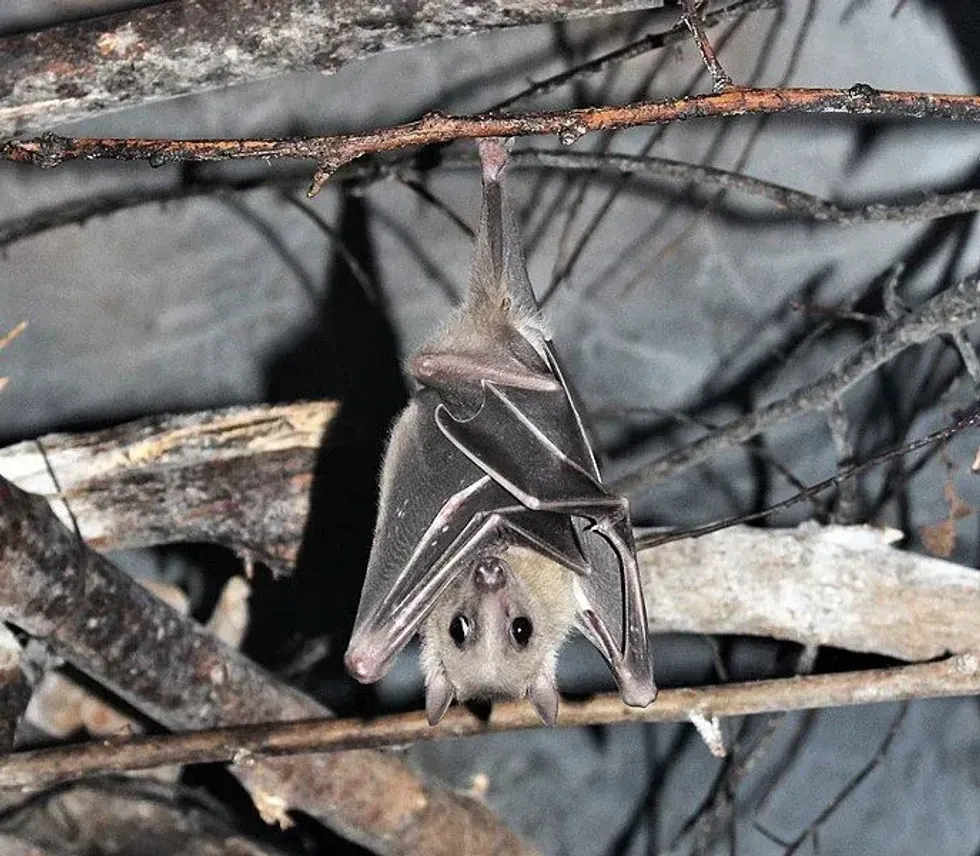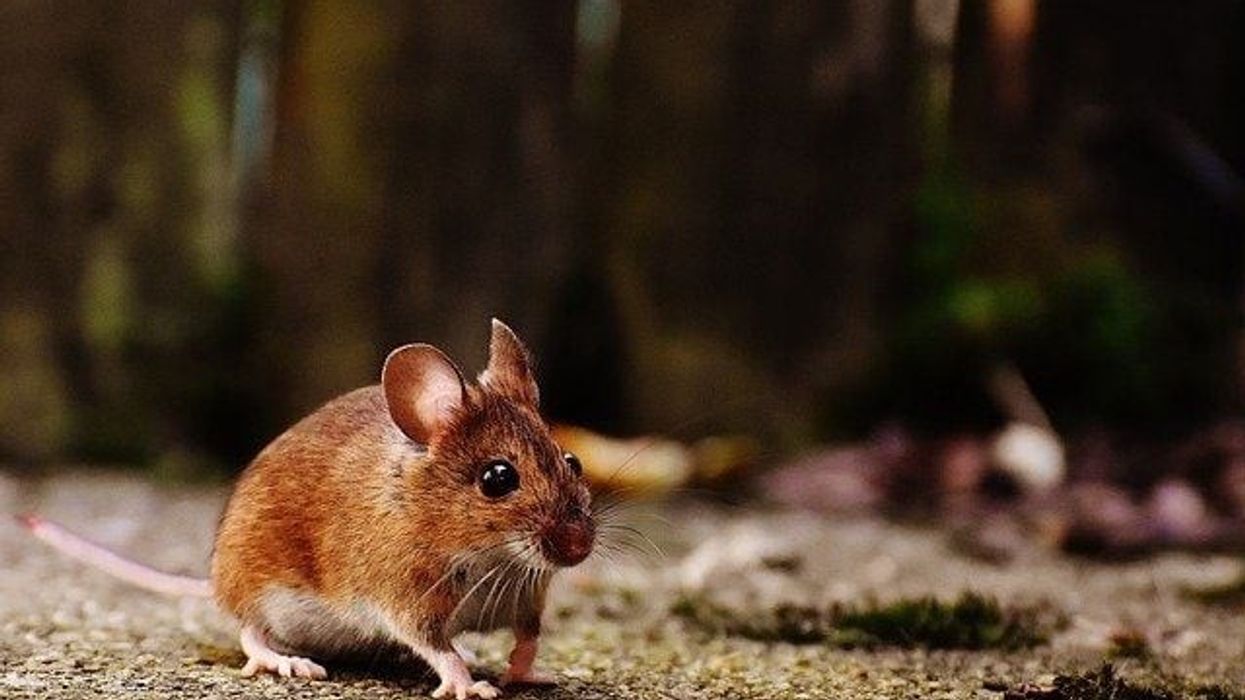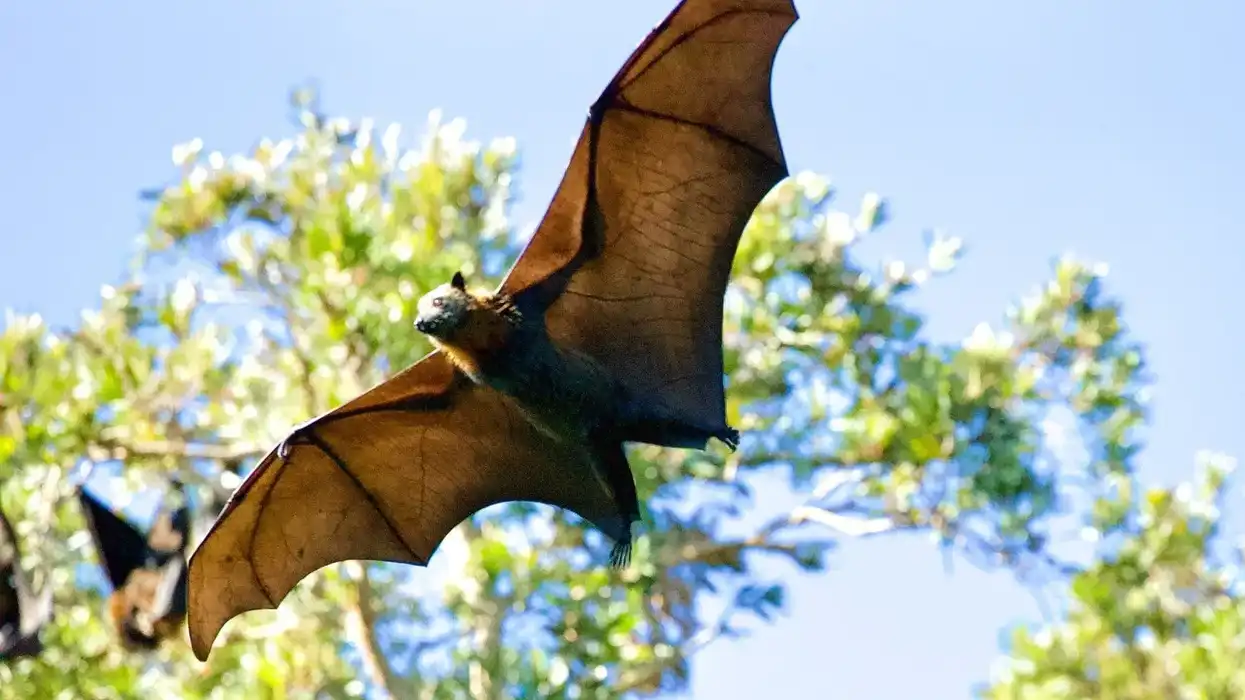Want your child to know about flying mammals? You may introduce them to this one!
The Rousettus aegyptiacus is found in the three continents of Asia, Africa, and Europe. These old-world bats are nocturnal and are a sedentary and territorial species. Egyptian fruit bats are megabats with a wingspan of 32 in (60 cm).
They are endothermic and have bilateral symmetry. The fruit bat, Rousettus aegyptiacus, has a fox-like face and hence is called a flying fox! The choroid in the eyes of these animals has minuscule projections called papillae.
The papillae have photoreceptor cells. These bats are highly adaptable to changes. The fruit bat, Rousettus aegyptiacus, is arboreal.
Also, the Egyptian fruit bat is migratory. Human activities like hunting, deforestation, and tourism in caves are proving to be a threat to these animals. It is decreasing their space for roosting.
Like reading about this mammal? Want to know more? Let's move further!
If you like reading about this, you may also like reading about the vampire bat and megabat.
Egyptian Fruit Bat Interesting Facts
What type of animal is an Egyptian fruit bat?
The Egyptian fruit bat is a bat belonging to phylum Chordata, subphylum Vertebrata, order Chiroptera, subfamily Pteropodinae, and species R. aegyptiacus.
What class of animal does an Egyptian fruit bat belong to?
Egyptian fruit bat belongs to the class Mammalia, that is, it is a mammal.
How many Egyptian fruit bats are there in the world?
Egyptian fruit bats have a stable population in the world. It is estimated that there are around 40,000-50,000 individuals in Africa only!
Where does an Egyptian fruit bat live?
The Egyptian bat's habitats include montane grasslands, shrublands, tropical savanna, tropical moist forests, desert, and xeric shrublands. Fruit bats prefer habitats with forest cover that helps them build roosting colonies. Fruit bats are also found in caves.
What is an Egyptian fruit bat's habitat?
The Egyptian fruit bat is found in India, Arabian Peninsula, Pakistan, Sub Saharan Africa, North Africa, the Mediterranean region, and the Middle East.
Who do Egyptian fruit bats live with?
The Egyptian fruit bat is a social animal. It lives with thousands of other bats in the roosting colony. They are found in groups of 20-40 to groups of 9,000 in the colonies.
How long does an Egyptian fruit bat live?
In natural habitats, Egyptian fruit bats can live around 8-10 years. When in captivity fruit bats tend to live up to 22 years.
How do they reproduce?
Breeding occurs in the month of April to August and October to February. Males form bachelor groups while the females form maternity colonies. The male gives a nuptial gift to the female.
Females have better control over copulation. The mating system can be polygynandrous or polygynous. Females give birth to a single pup or twin pups.
The gestation period for the mothers is 3.5-4 months. The pups stay for 9 months with the mothers. After 9 months the pup roosts separately. They are weaned till 6-10 weeks of birth.
Sexual maturity may occur earlier in females than in males. The pups have no difference in sex in terms of growth. Newborn pups are altricial (born underdeveloped hence needing parental care).
What is their conservation status?
According to the International Union for the Conservation of Nature (IUCN) Red List, Egyptian fruit bats are classified as of Least Concern.
Egyptian Fruit Bat Fun Facts
What do Egyptian fruit bats look like?
The flying foxes have soft fur that is dark brown to grey in color. The Egyptian fruit bats have large eyes and a long muzzle. Males are larger than females. These bats have claws only on the first two digits.
The other digits are covered in cartilages. The wings have a darker color. The body length is medium.
The wingspan is medium. The animal has ears that are medium in length. The forearm is 3.3-4.3 in (8.5 to 10.2 cm) in males and 3.4-3.8 in (8.8 to 9.9 cm) in females. Each of its hind limbs has five digits ending in claws.
How cute are they?
Egyptian fruit bats are cute! The baby is absolutely adorable.
How do they communicate?
The Egyptian fruit bats use visual, chemical, and acoustic channels to communicate. The perception channels used by them are visual, chemical, and tactile.
How big is an Egyptian fruit bat?
The flying fox male is 5.5-7.5 in (14-19.2 cm) while the female is 4.7-6.5 in (12.1-16.7 cm) in length. This bat is comparatively bigger than other bats belonging to the same genus.
How fast can an Egyptian fruit bat fly?
The rousettes can fly pretty quickly. It makes well use of its wings and also uses echolocation to navigate. However, the echolocation used by this bat is different from those used by other species.
How much does an Egyptian fruit bat weigh?
The adult weight of the Egyptian fruit bats is 2.8–6.0 oz (80–170 g).
What are the male and female names of the species?
The males and the females of the species do not have separate names as such.
What would you call a baby Egyptian fruit bat?
The baby of Egyptian fruit bats is called a pup!
What do they eat?
As the name suggests, Egyptian fruit bats are frugivores, that is, they feed on the pulp and juice of the fruits. They prefer soft fruits like dates and apricots. They also eat leaves.
Are they dangerous?
Whether these bats are dangerous to humans or not is a matter of research. Some evidence points to the fact that these bats may spread the Marburg virus in humans. However, they are found in considerable numbers in many zoos across the world. The animal is known to be seropositive with the Ebola virus.
Would they make a good pet?
They may not be good when kept in close contact as pets. In many countries, it is illegal to keep a flying fox as a pet.
Did you know...
These fruit bats are classified as primary consumers. They have a circadian rhythm that is adaptable to the seasonal light and dark cycles. In some parts of the world, these bats are considered symbols of good fortune.
There are 1,400 species of bats found throughout the world. They prefer to live in slightly humid conditions. Some examples include the ghost bat, red bat, and hoary bat.
Bats tend to carry diseases. They are the carriers of many viruses. These diseases have contaminated humans as well like Ebola and SARS.
Bats are found almost everywhere in the world barring extreme regions like the polar regions.
Egyptian bats are preyed upon by the birds like hawks and falcons. Some mammals are also known to hunt these bats.
Egyptian fruit bats are the major pollinators of fruit crops worldwide. As they feed on fruit crops and infest fruit trees, they are considered pests by fruit farmers. Often colonies are destroyed and they get killed as a result.
A fight between two bats looks like boxing with half-open wings.
They are carriers of several ectoparasites and endoparasites. Ectoparasites like Spinturnix lateralis and Ancystropus leleupi are carried by the bats. Endoparasites like the hemosporidian Plasmodium roussetti are carried. A group of bats is called a cloud or a colony!
The bats are excellent dispersers of seeds of fruits and other trees. The baobab tree depends largely on this bat for the dispersion of its seeds.
The bats are also called 'dog bats' due to their appearance. The individuals lie upside down when sleeping.
Are Egyptian fruit bats aggressive?
Egyptian bats become aggressive when they are feeding. This is because these bats tend to snatch the meals of each other.
What is the most dangerous bat?
The most dangerous bat is the vampire bat. It is found in Central America and South America. There are three subspecies of vampire bats namely the common vampire bat, the white-winged vampire bat, and the hairy-legged vampire bat. Their name originates from the fact that they feed on the blood of their victims. This trait is termed hematophagy.
Here at Kidadl, we have carefully created lots of interesting family-friendly animal facts for everyone to discover! For more relatable content, check out these ragdoll facts and Southern plains woodrat facts pages.
You can even occupy yourself at home by coloring in one of our free printable egyptian fruit bat coloring pages.










